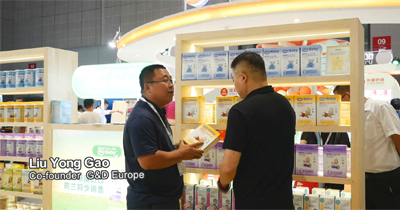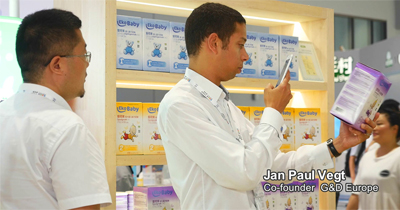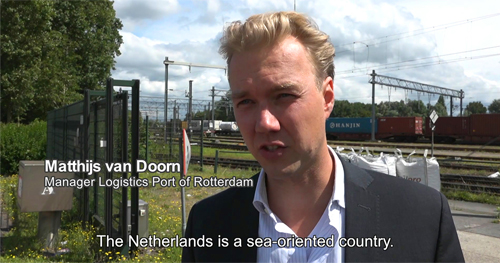G&D group is a Dutch based company exporting organic baby food and milk to China. The company was co-founded by Jan Paul and Liu Yong. G&D participated in the just ended 16th Child Baby Maternity Products Expo in Shanghai China in a bid to expand their market. After the Expo, the two cofounders took time to discuss their biggest logistical challenge; transport. Their discussions yielded in the two cofounders deciding to give railway transport a chance.
Jan and Liu cite air transport as costly having incurred more than 4 million Chinese Yuen Renminbi for just three urgent orders within a year. Sea freight had once caused them a two-month delay owing to foggy conditions. These challenges have pushed them to consider trying rail transport to meet the increasing demand orchestrated by express orders. However it’s not yet clear whether they will be able to use a train departing from Rotterdam considering that most trains arrive and depart to China from Germany.


The port of Rotterdam is doing their best to get connected to get their port connected to their harbor connected to China by rail. This evidenced by Matthijs Van Doorn sentiments. Matthijs is the Logistics Manager at the Port of Rotterdam. He argues that the expansion of China rail to Rotterdam will ease the movement of goods and connect it to Port of Rotterdam’s sea bound services. The end of the video footage is marked by revelation by John that Liu has named his name Rotterdam after the city just to underscore the importance of the city to their business.
Just like John and Liu, many entrepreneurs in China encounter the same problem. An IGC report published in 2010, indicated that regions closer to transport networks exhibited higher GDP per capita levels and higher income inequality and a higher number of industries. More GDP growth was also experienced by companies and counties closer to historical infrastructure. The report further indicates that transportation leads to substantial savings on the cost incurred by businesses. The report, however, explains findings further mitigated by limits on the mobility of capital, skill, and management within the country. This report interpreted that transport infrastructure, among other factors, contributes to the growth in GDP.
The Links role in trade
The first train carrying containers from China first arrived at Rail Service Center (RSC) freight terminal in the port of Rotterdam on July 23 of 2015. The train left Kunming on July 5. This historic journey was hopped to mark the begging of a more reliable, efficient and affordable form of transport between China and Netherlands. The railway link will most certainly bring to an end the transport woes experienced by entrepreneurs like Paul and Liu. If findings published by the IGC report is anything to go by, then the railway link is expected to facilitate further growth in the Chinese GDP. The maiden trip containing 80 containers from China were routed via the Zabykalsk border and transferred from 1520 mm gauge to 1435 mm gauge wagons at Malaszewice. The success of this first train is also a significant step in the implementation of the International Silk Road transport corridor.
The China to Rotterdam railway link is ultimately expected to further improve the trade ties between China and Netherlands. The two nations are enjoying good relations firmly founded on trade and upholding international legal order. The flow of raw materials and finished goods are expected to flow between the two countries. It is also expected to convince businesses that are still on the fence to join in the fray of companies now using transporting their goods from one continent to another using rail.
Hewlett-Packard (HP) is already using the railway link to carry goods between China and Europe. Ricoh Europe is also enjoying the link’s services between China and Europe. The Transport Manager at Rico, Mia Craeghs hails the link as more affordable, fast and instrumental in effective planning. Mia affirmed that the firm had by June 2016 transported 75 containers via the railway link. He further asserted that they fitted gadgets allowing them to monitor temperature, humidity, and vibrations. Based on the data they received, they were assured that the containers are handled correctly. Mia also claimed that they also chose this means of transport since it has lesser carbon emission compared to planes. G&D Europe was also to try out the link this summer. It is hoped that other companies will pick the cue from them and subscribe to the services of the China to Rotterdam railway link.
The challenges facing the railway link
Despite the apparent success currently being exhibited by the track, there are numerous challenges glaring at it. To maintain the operations of the link, a steady stream of imports and exports are required. At the moment, there are few exports from European countries. The link is also facing competition from other lines providing low-cost overland transport from China to Europe. This could impede the efforts to improve the stream of goods between the East and the West in a bid to make the railway link sustainable. The railway link also has to change gauges twice. The first transfer is to the Russian gauge and occurs at Alatawa Pass. The second transfer is to the standard gauge, and it occurs at Poland border Belarus. The transfers are accomplished using cranes and are undertaken by DB Schenker. These transfers are time-consuming and raise the costs of operation.
Despite the challenges, the accrued benefits from the China to Rotterdam railway link are numerous. Entrepreneurs like Paul and Lui can now able access their markets faster and with less logistical challenges. Both the Western and Central Asian countries are going to reap from the connectivity offered by the railway. This is mostly so considering that Central Asian countries are inland states hence railway is crucial for the movement of goods. It can only be hoped the stream exports and imports grows the further.



